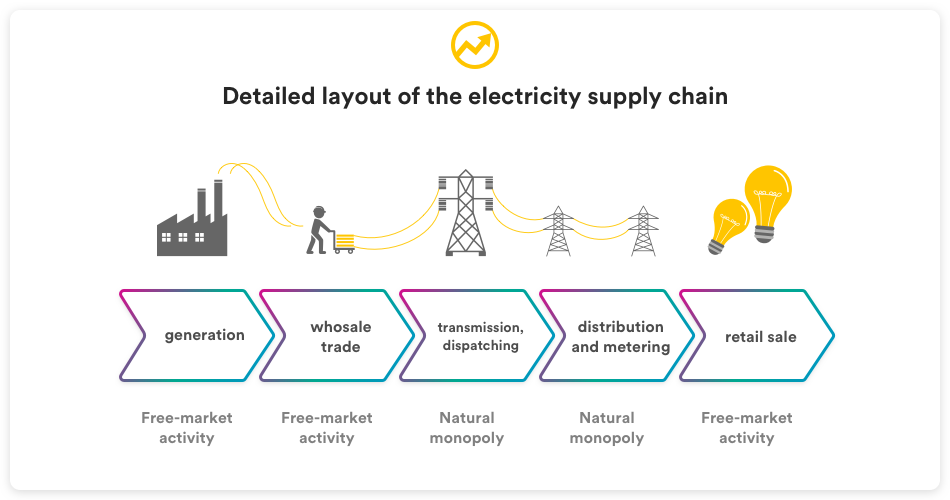Electricity
Electricity
- Group
- Business Activities
- Energy
- Electricity
Detailed layout of the electricity supply chain
The supply chain is the sequence of production steps beginning from the raw material and ending with the finished product. In the case of electricity, this is the series of phases from production to consumption. When you turn on a lamp, you are participating in the last part of a complex system. The supply chain begins with procurement, which takes place through the generation or import of energy, goes from transmission (‘controlled’ by dispatching activities) to distribution and ends with sale to the end customer.

Production or generation
Production or generation is the transformation of primary sources of energy into electricity using specific plants, and its subsequent injection into the transport network.
Transformation plants are:
- thermal plants: they exploit the heat produced by a heat source (solid/liquid fuel, natural gas, geothermal energy, nuclear reactions, etc.) to generate electricity
- plants using mechanical sources: these plants transform the mechanical energy provided by the energy source used (waterfalls and currents, wind, tides, etc.) into electricity
- plants not included in the types noted above, or those which may use different energy sources, such as photovoltaic plants that use solar radiation, plants with hydrogen cells that make use of flows of electrons deriving from chemical reactions, etc.
Electricity production is a free-market activity, but no market player is allowed to control (directly or indirectly) more than 50% of the energy generated and imported.
Wholesale trade
The electricity produced is sold to wholesalers (or traders) through bilateral supply contracts or through transactions amongst the various operators that may be carried out in the electricity market called the IPEX (Italian Power Exchange). As a result, in the area of procurement, the prices paid by wholesalers to purchase energy raw material are free and determined by contracts entered into by the parties (bilateral contracts) or the meeting between demand and supply (electricity market).
Transmission
Transmission consists of the transport of electricity through the national network at high or ultra-high voltage, to deliver it in regional distribution networks to local distributors connected to end users.
The electricity transmission sector is considered to be a natural monopoly, in which ownership and management is entrusted to a single party, TERNA, which must guarantee transparency and impartiality in grid access.
The infrastructure area is a fundamental part of the entire electricity market supply chain. This is where all activities necessary to deliver the electricity produced or imported to the end customer take place (transmission and distribution).
As electricity is not easy to store, in the power grid the energy produced must correspond to the energy consumed, net of losses. In practice, balance between demand and supply must be maintained at all times.
As a result, it is necessary to produce the quantity of energy required by consumers moment by moment while also managing transmission so as to always ensure a certain equilibrium between demand and supply, thereby guaranteeing supply continuity and security.
This important function is known by the name of dispatching.
Dispatching activities
Dispatching is functional to transmission activities in the sense that management and control of the electricity system helps to guarantee that the energy produced and injected into the national network always coincides with the energy withdrawn by end users, as it is possible to store only small quantities of electricity.
Distribution
Distribution consists of transporting electricity via local networks for delivery, through the sales activities of sales companies, to end customers as well as all associated activities for the interconnection of end users.
Distribution companies are also responsible for surveying and validating metering data present in meters (metering units) as well as distribution settlement, i.e., all activities and reports required under the regulation for the distributor to entities and sales companies to determine physical and financial data (energy reporting) for the electricity dispatching service.
To promote network streamlining, the concession of distribution activities is limited to one operator for each municipal area.
Sales
Sale, or the retail sale of electricity, is the last link in the supply chain and regards exclusively the vendor and the end customer entering into a contract regarding the volume and price of the raw material.
With regard to the electricity market, 16% of sales to end customers on the free and protected market were covered by bilateral purchases from other operators, and 84% sourced on the electricity exchange. The methods for trading electricity, both via sourcing on the electricity exchange and, in particular through bilateral agreements, do not allow for the tracing of the physical sources of energy in order to be able to certify the type of production upstream.

Hera Comm, a commercial company of the Hera Group, is the third national operator in the sale of gas and electricity in terms of number of customers and it operates throughout Italy.
It is the operator of the Safeguard Regime Market for the term 2021/2022 in Campania, Abruzzo and Umbria.
Hera Comm also provides the basic energy electricity standard offer service in the cities of Imola (BO), Modena and the surrounding municipalities.
The company, with its headquarters in Imola (BO), was established in 2001 and enjoyed continuous and significant growth in the years that followed. A market development made possible by a commercial strategy based on product innovation and a multi-business offer capable of responding to the consumption requirements of different market segments, from domestic to industrial, passing through the diverse world of VAT registration numbers. Hera Comm operates through a commercial network structured and differentiated according to the market segments it targets.
It currently supplies electricity to 1.4 million of customers, selling a total of 12.2 TWh.
Page updated 7 July 2023
Creating shared value report 2024
